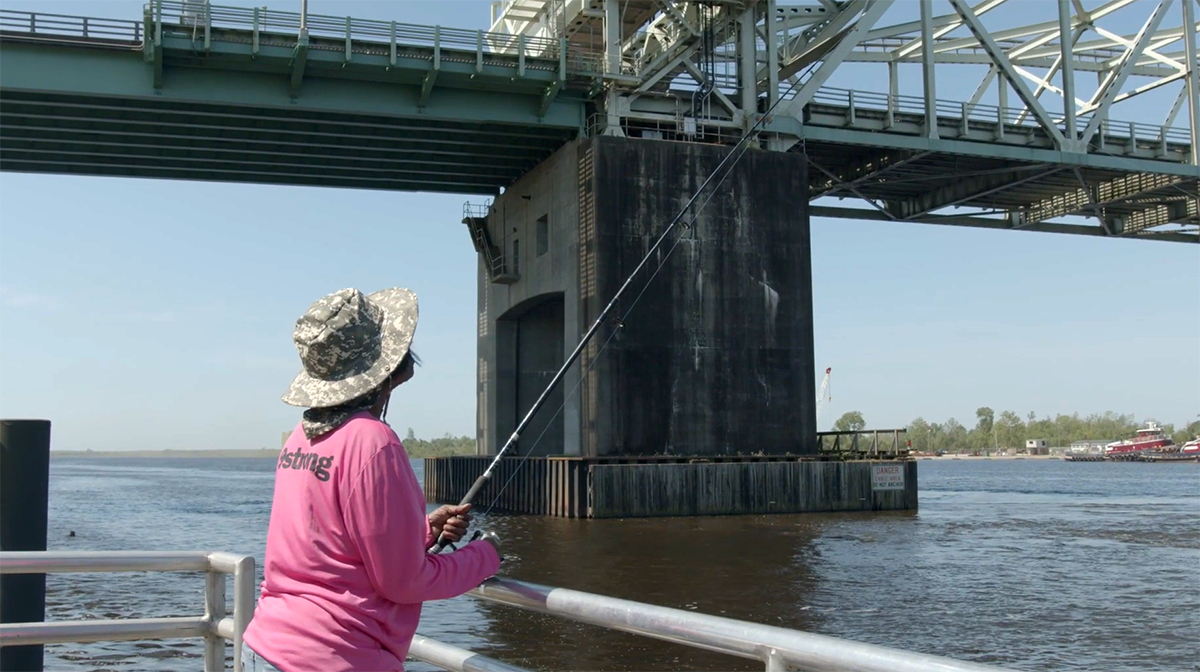
A study of fish routinely caught in the Cape Fear and Brunswick rivers as a source of food for people in low-income communities has prompted the state to update its fish consumption advisories.
The North Carolina Department of Human Health and Services in October issued updates advising consumers against eating certain species of fish from areas of both rivers after a Duke University-led study found elevated levels of chemicals known to cause cancer and affect neurological systems in humans.
Supporter Spotlight
In the Cape Fear River between Riegelwood Landing and the river’s confluence with Livingston Creek, bluegill, bowfin and channel catfish caught by researchers contained elevated levels of arsenic, hexavalent chromium and mercury, according to the North Carolina Department of Health and Human Services advisory.
“People should not eat bowfin and channel catfish due to elevated levels of hexavalent chromium and mercury,” the advisory states. “People should eat no more than 1 meal per week of bluegill due to elevated hexavalent chromium.”
That area of the river includes Columbus, Pender and Brunswick counites.
Red drum caught in the Brunswick River near the U.S. 74/U.S. 17 bridge in Brunswick County also contained elevated levels of the same pollutants.
The state is advising people not to eat red drum due to the higher levels of hexavalent chromium found in that species in the Brunswick River.
Supporter Spotlight
The updates were made as a result of research ultimately borne out of a collaborative effort going back a few years ago at the pinnacle of a locally charged fight against a cement-production company from building a plant on the banks of the Northeast Cape Fear River in New Hanover County.
Activists and environmentalists giving federal and state agency officials a tour to show how the river would be impacted if the cement plant were to be built there noticed people, sometimes whole families, fishing off the river banks.

“They knew those folks were taking that fish home to eat and they were very concerned about it,” said Elizabeth Shapiro-Garza, director of Duke Superfund Research Center Community Engagement Core.
The movement to stifle Titan America LLC’s plans to build a cement plant on more than 1,000 acres on the Northeast Cape Fear River ended in 2016 with the company pulling the plug on its plan.
The group that led the tour of officials from the Environmental Protection Agency and North Carolina Department of Environmental Quality won the fight, but they had not forgotten the people, those families, who fish the river for sustenance.
Around the same year Titan backed out of its plans for a Castle Hayne plant, a coalition that included the New Hanover County branch of the National Association for the Advancement of Colored People, Cape Fear River Watch and the Duke Environmental Law and Policy Clinic, applied for funding from the EPA’s Environmental Justice Collaborative Problem-Solving Cooperative Agreement Program.
Under the program, financial assistance is given to organizations that work or plan to work on local environmental and/or public health issues projects within their communities.
“The idea behind that grant was to do research to do a household survey in low-income neighborhoods along the Cape Fear to find out what kind of fish people were eating, how much they were eating, who was doing the eating and how they’re preparing the fish,” Shapiro-Garza said.
What they found is that people are eating fish from the river. They’re sharing it with their families, their children, and their neighbors, she said.
“People are eating portion sizes and quantities that are likely to be detrimental to their health, especially children,” Shapiro-Garza said.
That’s a fact many of the people included in the survey were unaware, according to the research.
The state does issue fish consumption advisories, but the study revealed that there are a couple of issues with those advisories.
Signs are posted in some areas by the river containing information about the advisories, but they include a lot of text and can be hard to understand.
The second issue is that the state’s information tends to be out of date and, in some cases, based on sampling of fish people are not eating.
Mozhgon Rajaee, an assistant professor of public health with Oakland University in Rochester, Michigan, was teaching environmental justice at Duke as a visiting professor, a spot she got through a fellowship in 2018-2019.
During her time there, she met Shapiro-Garza and the two soon found they had common interest in environmental justice issues.
“They’d already done some work on how people were consuming fish in the Cape Fear River, particularly the lower Cape Fear,” Rajaee said.
Their discussions of environmental justice evolved into how they could look further into sustenance fishing in the Cape Fear River.
Once they secured funding for research, Rajaee took a year off from teaching up north and headed back to North Carolina in 2020 to start collecting species of fish popular among people who fish the Cape Fear for food.
Rajaee and field technicians caught fish at five different sites along the river. They tested seven species in all — blue, channel and flathead catfish; bowfin; bluegill; red drum; and blue crab.
They caught a little more than 130 fish and crab.
“We measured mercury, arsenic and chromium in almost all of the fish that we analyzed,” Rajaee said. “Part of the research was to try to figure out how to fill in the gaps on data. Fish weren’t sampled in the lower Cape Fear frequently.”
Frankly, they were expecting to find contamination in the fish they caught.
The Cape Fear River, which is the drinking water source of tens of thousands of people in Wilmington and surrounding areas, has been plagued by pollutants.
Sources of pollution come from everything like industrial facilities to hog farms and other agriculture operations, powerplants, wastewater treatment plants and landfills, and unregulated, nonpoint source runoff.
There’s been a growing awareness of chemical contaminants in the river in recent years since researchers revealed the Chemours Fayetteville Works Facility has for decades been discharging “forever chemicals” known as per- and polyfluoroalkyl substances, or PFAS, into the lower Cape Fear.
“I think because of that people are probably more receptive to thinking about, OK what does that mean for the fish I’m catching out of the river and should I be eating it,” Shapiro-Garza said.
To help get the word out about the impacts these pollutants are having on fish in the Cape Fear River, Duke’s Community Engagement Core, in partnership with Cape Fear River Watch, community health educators in New Hanover County and the NAACP, launched in 2018 a campaign entitled “Stop, Check, Enjoy!”
Through community outreach events, health educators have been sharing the campaign message: vulnerable populations including pregnant women and children should Stop eating fish high in mercury; Check fish consumption advisories on fish from the Northeast Cape Fear River to stay in the know; and Enjoy locally caught fish by choosing fish that are not under advisory, are lower on the food chain and not bottom eaters, filleting fish first to remove fatty tissues where many contaminants except mercury can be found, and grilling or baking fish, which can reduce fat build-up and contaminant loads in fish.
Shapiro-Garza said in a statement that the release of the updated fish consumption advisories by the state is the result of endless hours of work by organizations within the partnership and “represents the power of their determination and persistence.”
“However, while it is a triumph, it’s not the end point,” she said. “With these further advisories for the lower Cape Fear and Brunswick Rivers our group now has a lot more information about what kind of wild caught fish and how much is safe to eat from where and a mandate, especially in the case of the county health departments, for making sure that word gets out to the people whose health is at risk.”








